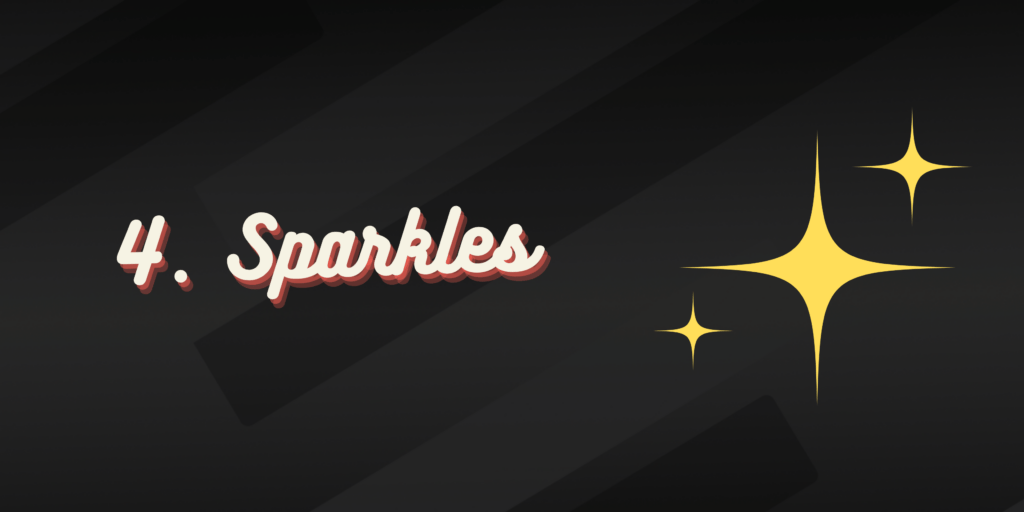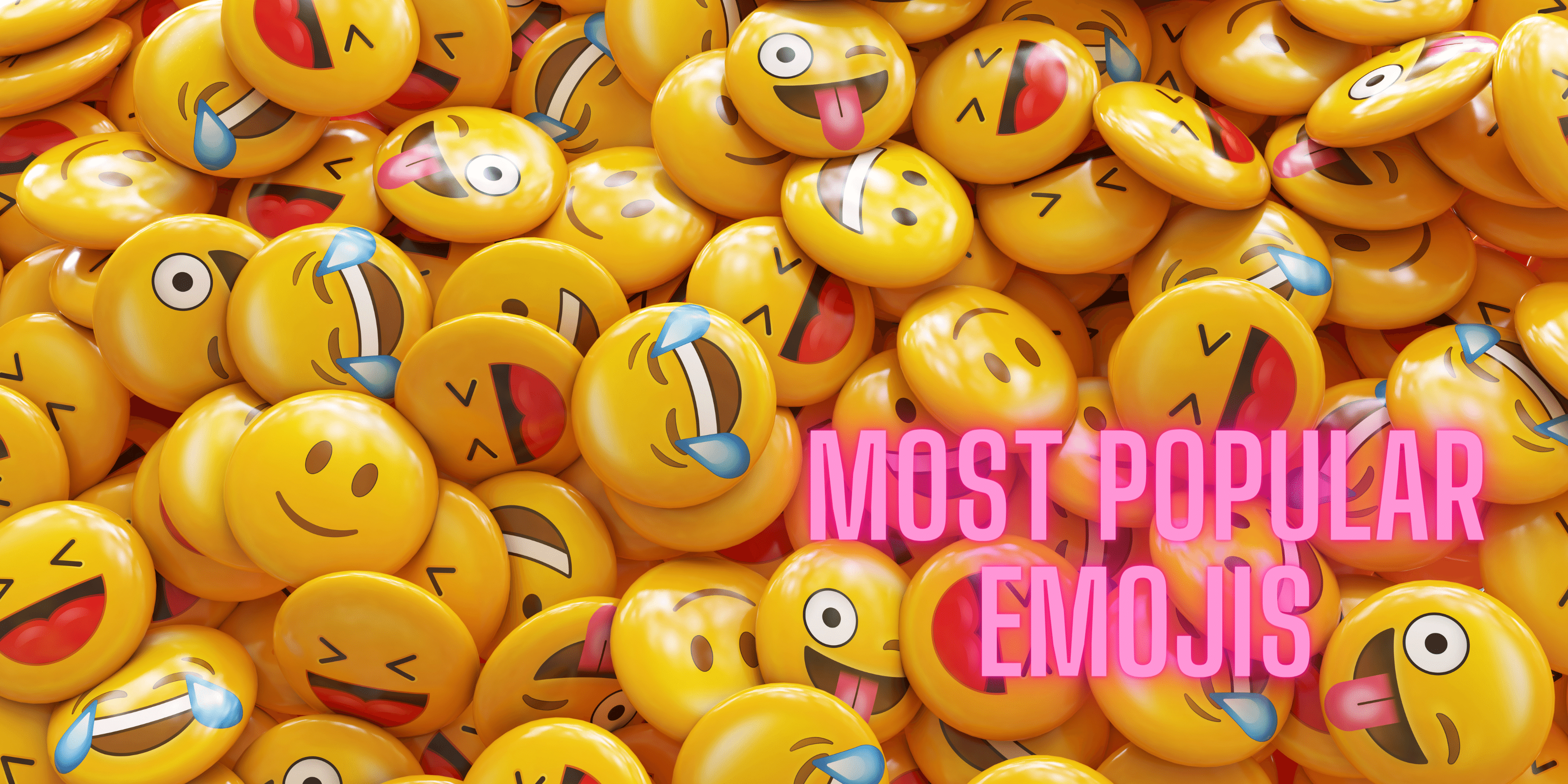
10 Apr 20 MOST POPULAR EMOJIS
In the vibrant landscape of digital communication, where words alone often fall short, emojis have emerged as the universal language of expression. These small pictograms, originally conceived to add nuance and emotion to text-based conversations, have transcended their humble beginnings to become indispensable tools for conveying sentiments across various digital platforms.
At Amra and Elma we delve into the colorful and fascinating world of emojis, uncovering the most popular and widely-used symbols that have captured the hearts and imaginations of billions worldwide. From the tears of joy to the heart-eyed faces, each emoji holds a unique significance, reflecting the diverse spectrum of human emotions and experiences in the digital age.
Join us on a journey through the emoji lexicon as we explore their evolution, cultural impact, and the fascinating stories behind some of the most beloved and iconic symbols in the digital realm. Whether you’re a casual user or an emoji aficionado, prepare to be enchanted by the rich tapestry of expressions that these tiny icons offer, illuminating the way we communicate and connect in an increasingly interconnected world.
20 Most Popular Emojis
4. Sparkles
5. Crying Face
6. Folded Hands
9. Fire
10. Smile Face
11. Kiss Mark
12. Party Popper
13. OK Sign Hand
14. Eye Roll
16. Facepalm
17. Winking Face
18. Clapping Hands
19. Flexing Biceps
20. Eyes
What Are Emojis?
Emojis are small digital icons or symbols used to express emotions, ideas, or concepts in electronic communication. They originated in Japan in the late 1990s and have since become an integral part of digital communication worldwide. Emojis cover a wide range of subjects, including facial expressions, animals, food, activities, and objects. They are commonly used in text messages, social media posts, emails, and other forms of online communication to add nuance, tone, and emotional context to written messages.
Emojis play a crucial role in facilitating clearer and more expressive communication, particularly in situations where tone and body language may be absent. They continue to evolve, with new emojis being regularly added to reflect changes in language, culture, and technology.
Why Are Emojis Popular?
- Universal communication: Emojis serve as a universal language that transcends linguistic and cultural barriers. They provide a means of communication that is easily understood by people from diverse backgrounds, allowing individuals to express emotions and convey messages more effectively in the globalized digital world.
- Cultural representation: Emojis reflect and represent various aspects of culture, including symbols, traditions, and everyday experiences. From food and clothing to holidays and celebrations, emojis offer a visual representation of cultural elements that resonate with people worldwide, fostering a sense of cultural inclusivity and recognition.
- Digital expression of identity: Emojis enable individuals to express their identity, emotions, and experiences in digital communication. People can personalize their messages by selecting emojis that reflect their personality, interests, and cultural background, allowing for greater self-expression and authenticity in online interactions.
- Cultural exchange and understanding: Emojis facilitate cultural exchange and understanding by showcasing diverse perspectives and experiences. Through the use of emojis representing different cultures and customs, individuals can learn about and appreciate the richness and diversity of the world, fostering empathy, respect, and mutual understanding across cultural boundaries.
- Integration into popular culture: Emojis have become integrated into popular culture, influencing art, fashion, advertising, and media. They have become symbols of contemporary digital communication and are frequently used in memes, social media trends, and advertising campaigns, shaping modern cultural discourse and expression.
- Digital evolution of language: Emojis contribute to the evolution of language and communication in the digital age. They complement written text by adding emotional nuance, humor, and context to messages, enriching communication in ways that traditional text alone cannot achieve. As a result, emojis play a significant role in shaping the evolution of digital language and communication norms.

Most Popular Emojis
#1 Most Popular Emoji: Face with Tears of Joy
The Face with Tears of Joy emoji, characterized by its wide grin and tears streaming down its face, has become one of the most popular emojis across digital platforms. Its widespread appeal stems from its ability to capture the essence of joy and laughter in a universally understood manner, transcending linguistic and cultural barriers. This versatility allows users to employ the emoji in various contexts, whether reacting to a funny joke, expressing overwhelming joy, or simply lightening the mood in conversations.
Additionally, as one of the original emojis included in Unicode‘s set, the “Face with Tears of Joy” emoji holds a special place in the history of digital communication, often associated with online humor and meme culture. Its prominent placement on emoji keyboards and recognizable design further contribute to its ease of use, making it a convenient option for expressing emotions in real-time interactions.

#2 Most Popular Emoji: Red Heart
The “Red Heart” emoji stands as a timeless symbol of love, passion, and affection in the vast landscape of digital communication. Its simplicity and universality make it one of the most recognizable and widely used emojis across various platforms and contexts. With its vibrant hue and iconic shape, the red heart serves as a powerful visual representation of deep emotional connections and heartfelt expressions.
Whether shared between romantic partners, friends, or family members, this beloved emoji transcends language barriers, conveying warmth, care, and appreciation with just a single tap or click. Its enduring popularity speaks volumes about the human need for connection and the enduring power of love in our digital age.

#3 Most Popular Emoji: Thumbs Up
The “Thumbs Up” emoji has gained widespread popularity due to its ability to convey positive affirmation and agreement succinctly in digital communication. This simple gesture symbolizes approval and support, making it a go-to choice for expressing encouragement, agreement, or satisfaction in various online interactions. Its popularity stems from its effectiveness in conveying positivity and affirmation with just a single tap or click, adding clarity and emphasis to messages without the need for additional words.
Moreover, the “Thumbs Up” emoji’s popularity is also attributed to its simplicity and clarity, making it easily recognizable and accessible across different digital platforms and devices. Its straightforward design leaves little room for misinterpretation, ensuring that the intended message of approval or agreement is conveyed accurately to recipients. This simplicity enhances the emoji’s versatility, allowing it to be seamlessly incorporated into both casual conversations and professional correspondence.
Another factor contributing to the popularity of the “Thumbs Up” emoji is its cultural ubiquity. The gesture of giving a thumbs up has transcended cultural boundaries and is widely understood as a symbol of approval or agreement in many parts of the world. This cultural recognition ensures that the emoji remains relevant and impactful in diverse linguistic and cultural contexts, further solidifying its status as a popular choice for expressing positive sentiments in digital communication.
#4 Most Popular Emoji: Sparkles
The “Sparkles” emoji, characterized by a cluster of glittering stars or sparkles, holds a special allure and popularity in digital communication. Its popularity can be attributed to several key factors.
Firstly, the “Sparkles” emoji adds a touch of magic and glamour to messages. It evokes a sense of wonder, excitement, or celebration, making it a versatile choice for expressing joy, enthusiasm, or admiration. Whether used to congratulate someone, express appreciation, or simply add a dash of sparkle to a conversation, this emoji effectively conveys a sense of positivity and excitement.
Secondly, the “Sparkles” emoji serves as a visual embellishment that enhances the overall tone and mood of a message. Its shimmering stars evoke a sense of whimsy and charm, instantly brightening up text-based conversations and adding visual interest to digital communication. This decorative quality makes the emoji appealing for a wide range of contexts, from casual chats to more formal exchanges.
#5 Most Popular Emoji: Crying Face
The crying face emoji has gained popularity due to its ability to convey complex emotions succinctly and universally. Emojis serve as a form of visual communication that transcends linguistic barriers, allowing individuals to express themselves effectively in various contexts. Whether it’s sadness, disappointment, grief, or sympathy, the crying face emoji encapsulates a wide range of emotions associated with tears and sorrow.
One of the key factors contributing to its popularity is its universal recognition. Regardless of cultural background or language proficiency, people can easily understand the sentiment conveyed by the crying face emoji. This universality enhances its utility as a communication tool, enabling users to express empathy, comfort, or their own emotional state with ease.
Moreover, the crying face emoji’s expressiveness plays a significant role in its widespread adoption. Emojis, in general, offer a concise way to convey nuanced emotions that may be challenging to articulate through words alone. The simplicity of the crying face emoji belies its ability to convey depth of feeling, making it a versatile and powerful tool for digital communication.
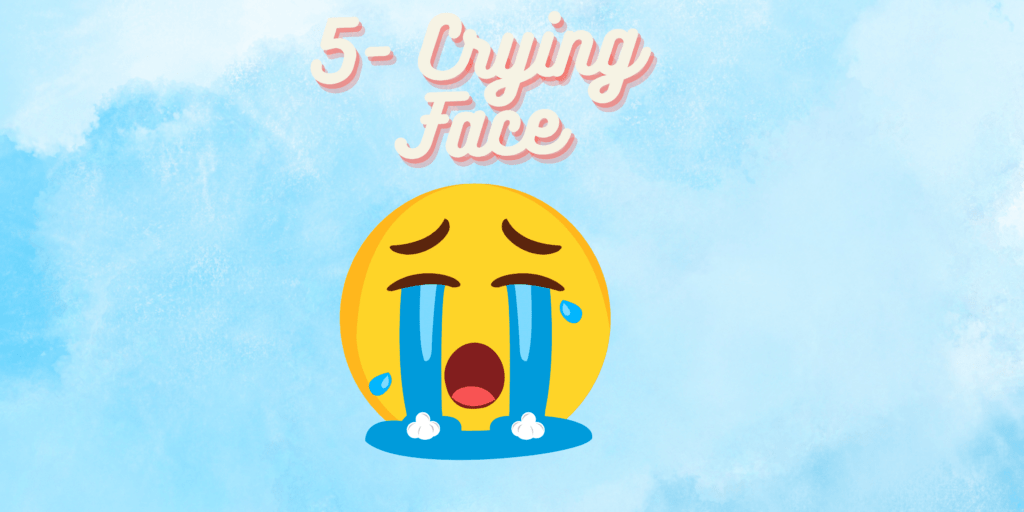
#6 Most Popular Emoji: Folded Hands
The folded hands emoji has gained popularity for several reasons, making it a widely used and versatile symbol in digital communication.
Firstly, the folded hands emoji is often interpreted as a gesture of prayer, gratitude, or respect across different cultures and religions. It conveys a sense of humility and reverence, making it suitable for expressing appreciation, support, or solidarity in various contexts.
Secondly, the folded hands emoji serves as a symbol of hope, encouragement, and empathy. Whether used to express condolences, offer comfort, or send well-wishes, it carries a message of compassion and goodwill, fostering connections and understanding between individuals.
Additionally, the folded hands emoji’s simplicity and universality contribute to its popularity. Like other emojis, it transcends language barriers, allowing people to communicate effectively in a visual and concise manner. Its straightforward depiction of a common gesture makes it easily recognizable and understandable, enhancing its utility in digital communication.
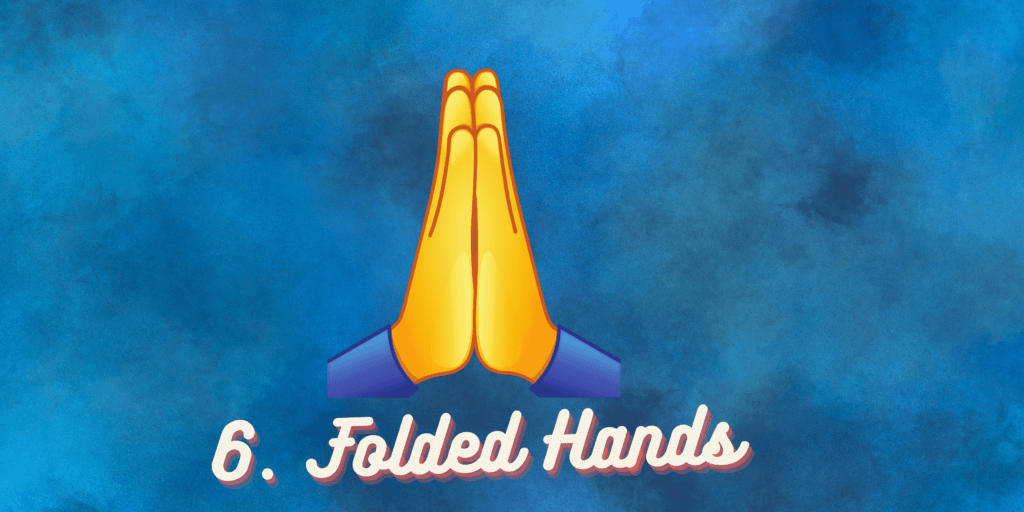
#7 Most Popular Emoji: Smiling Face with Hearts
The smiling face with hearts emoji has become popular due to its ability to convey affection, love, and admiration in a playful and expressive manner.
One reason for its popularity is its representation of positive emotions, particularly romantic ones. The combination of a smiling face and hearts conveys happiness, joy, and a sense of being enamored with someone or something. This makes it a go-to choice for expressing admiration, infatuation, or excitement, especially in the context of romantic relationships or crushes.
Another factor contributing to its popularity is its versatility. While the smiling face with hearts emoji is often associated with romantic feelings, it can also be used to express general appreciation, fondness, or enthusiasm for a variety of things, such as food, pets, hobbies, or even moments of joy and happiness in everyday life. Its broad applicability makes it a favorite among users looking to convey positive emotions in their digital communications.
Moreover, the smiling face with hearts emoji’s visual appeal plays a role in its widespread adoption. The combination of a smiling face and hearts creates a visually appealing and engaging image that stands out in text-based communication. Its cute and charming appearance makes it inviting for users to incorporate into their messages, whether they’re sending a heartfelt compliment, expressing affection, or simply sharing a moment of happiness with others.
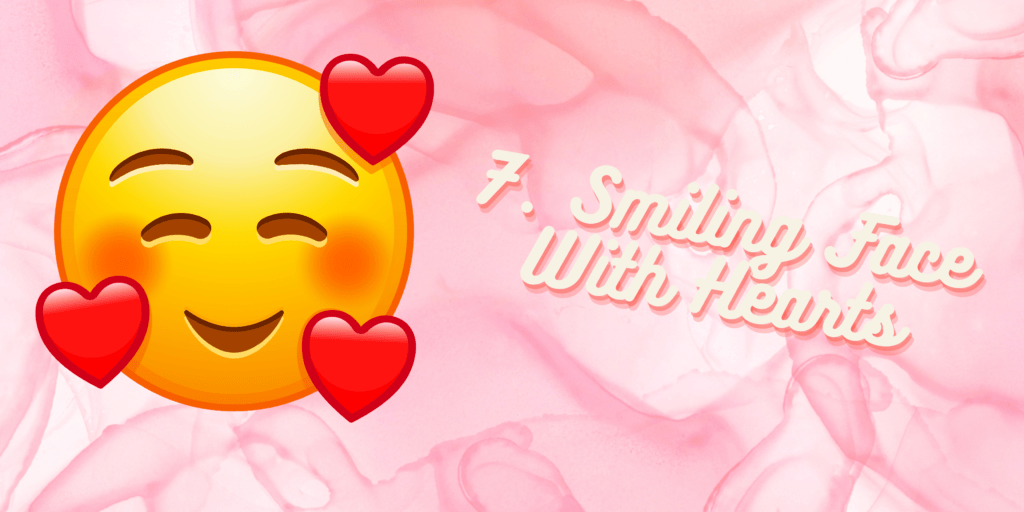
#8 Most Popular Emoji: Face Blowing a Kiss
The face blowing a kiss emoji has become popular due to its ability to convey affection, warmth, and intimacy in digital communication.
One reason for its popularity is its representation of a universally understood gesture: blowing a kiss. This physical gesture is commonly used to express affection, love, or appreciation in real-life interactions. By translating this gesture into a digital format, the face blowing a kiss emoji allows users to convey similar sentiments in virtual conversations, bridging the gap between physical and digital expressions of affection.
Another factor contributing to its popularity is its versatility. While the face blowing a kiss emoji is often associated with romantic feelings, it can also be used in a variety of contexts to express fondness, gratitude, or friendship. Whether used between partners, friends, or family members, the emoji’s ability to convey warmth and intimacy makes it a popular choice for expressing positive emotions in digital communications.
Moreover, the face blowing a kiss emoji’s simplicity and immediacy play a role in its widespread adoption. The image of a face blowing a kiss is instantly recognizable and requires no explanation, allowing users to convey their emotions quickly and effectively in text-based conversations. Its visual appeal and ability to evoke feelings of warmth and affection make it a beloved and frequently used emoji across various messaging platforms and social media channels.
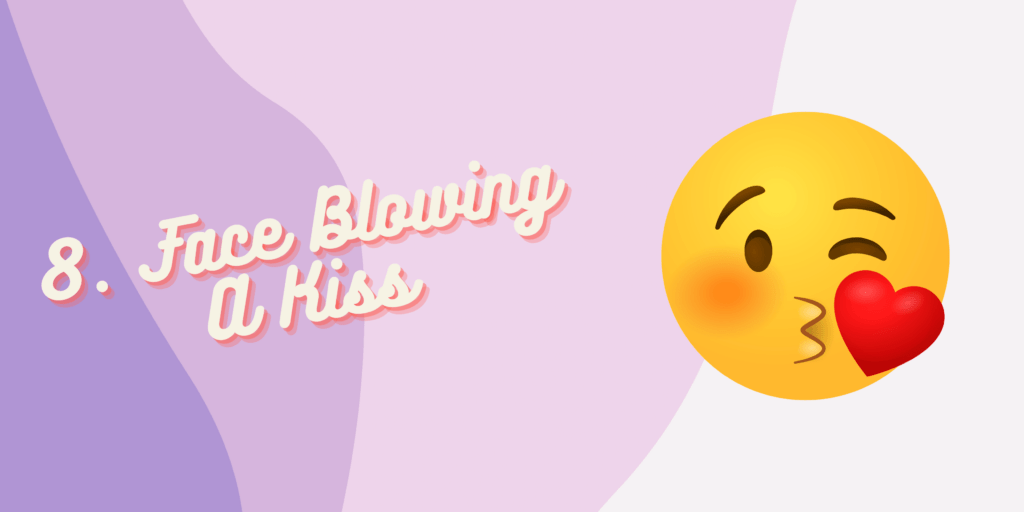
#9 Most Popular Emoji: Fire
The fire emoji is popular for several reasons. Firstly, its visual representation is significant. The fire emoji effectively symbolizes fire, an elemental force with deep historical and cultural significance. Fire has been essential for human survival, used for warmth, cooking, and protection. The emoji’s simple depiction encapsulates this powerful symbol in a universally recognizable form.
Moreover, the fire emoji is remarkably versatile, making it suitable for various contexts. It can represent actual fire, conveying heat, energy, and intensity. Beyond its literal meaning, it’s often used metaphorically to express excitement, passion, or admiration. Its adaptability allows users to convey a range of emotions and concepts succinctly.
Furthermore, the fire emoji’s widespread popularity is due in part to its association with digital culture. It has become a staple in online communication, particularly in social media platforms and messaging apps. Users incorporate it into their messages to add emphasis, flair, or to evoke specific sentiments.
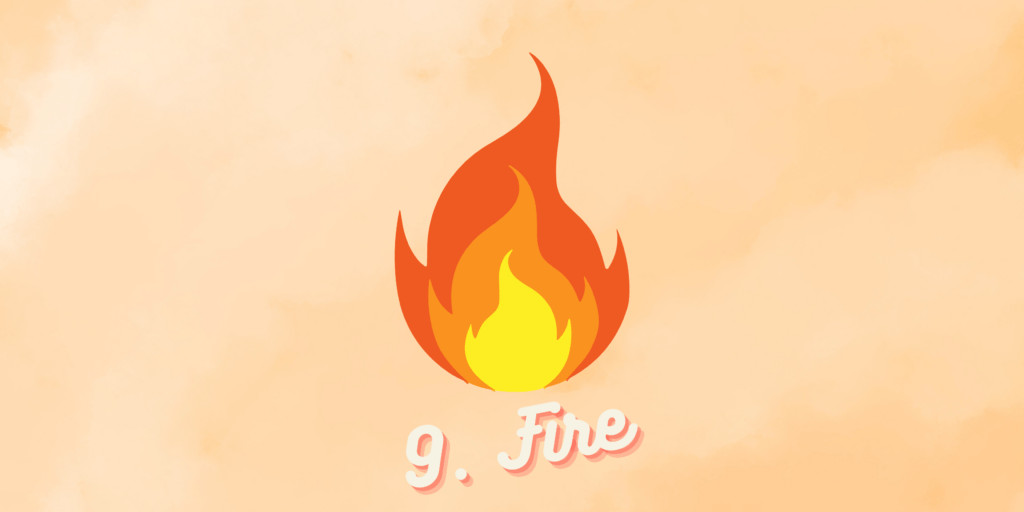
#10 Most Popular Emoji: Smile Face
The smiley face emoji is favored by users worldwide for its ability to convey positivity and happiness. Its simple yet powerful representation of a smiling face instantly uplifts messages and imbues them with a sense of warmth and friendliness. Whether used in casual conversations or professional communications, the smiley face emoji serves as a universal symbol of joy and goodwill.
Beyond its primary function of expressing happiness, the smiley face emoji is remarkably versatile. It can communicate a range of positive emotions, including gratitude, amusement, and contentment. Additionally, it serves as a subtle way to signal friendliness and approachability, making it an essential tool for fostering positive interactions in both personal and professional settings.
Furthermore, the smiley face emoji holds historical significance in the realm of digital communication. As one of the earliest and most recognizable emoticons, it predates the widespread use of emojis and remains an enduring symbol of connection in online interactions. Its longevity and widespread adoption underscore its timeless appeal and its role as a foundational element in modern communication platforms.
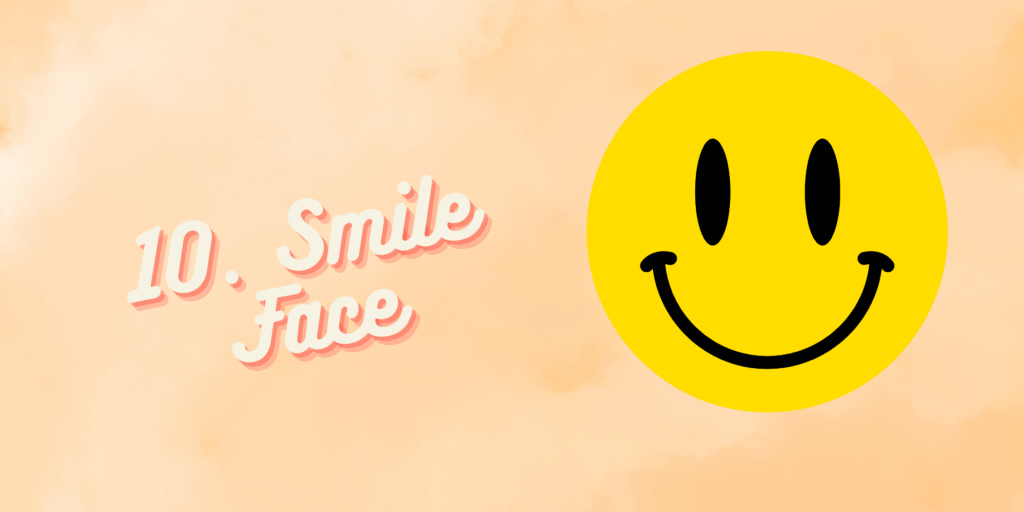
#11 Most Popular Emoji: Kiss Mark
The kiss mark emoji is widely popular for its ability to convey affection, love, and intimacy in digital communication. Its simple yet evocative depiction of lips pressing together serves as a universal symbol of affectionate gestures and romantic expressions.
The kiss mark emoji is versatile and can be used in various contexts. It can represent a blown kiss, a romantic gesture, or a sign of endearment between friends and loved ones. Additionally, it can add a playful or flirty tone to messages, enhancing the emotional depth of interactions.
Furthermore, the kiss mark emoji has become an integral part of modern communication, particularly in social media platforms and messaging apps. Users frequently incorporate it into their conversations to express affection, appreciation, or to convey romantic sentiments.

#12 Most Popular Emoji: Party Popper
The party popper emoji is celebrated for its ability to convey excitement, celebration, and joy in digital communication. Its vibrant depiction of a colorful party popper exploding in a shower of confetti encapsulates the festive atmosphere of various celebrations and special occasions.
This emoji is versatile and can be used in a multitude of contexts. It is commonly employed to mark birthdays, anniversaries, achievements, and other significant milestones. Additionally, it can be used to express enthusiasm, anticipation, or to simply liven up conversations with a touch of festivity.
Moreover, the party popper emoji has become a staple in online communication, particularly in social media platforms and messaging apps. Its inclusion in messages and posts serves to amplify the sense of excitement and camaraderie among users, fostering a shared experience of celebration and joy.
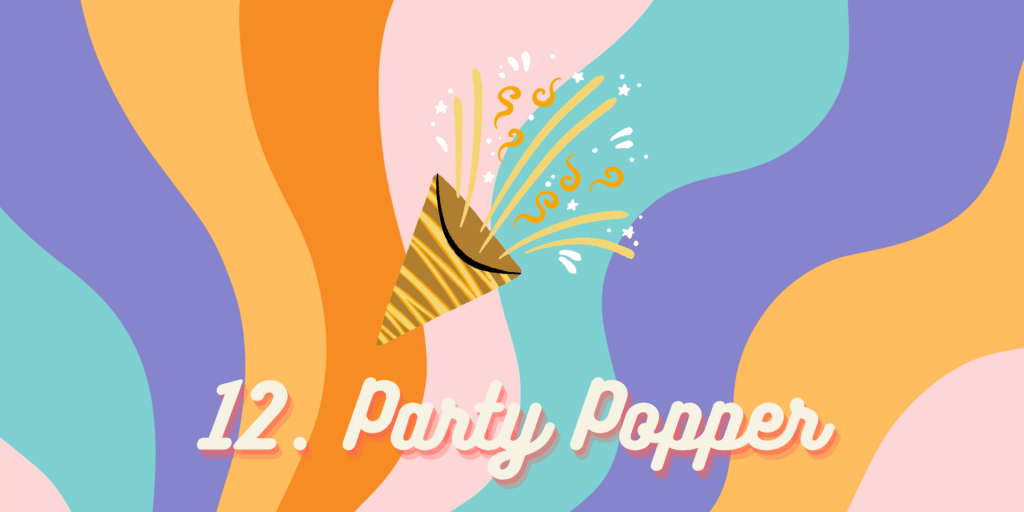
#13 Most Popular Emoji: OK Sign Hand
This emoji is widely recognized and appreciated for its versatility and positive connotations in digital communication. Its simple yet universally understood gesture of forming a circle with the thumb and index finger, while extending the other fingers, carries multiple meanings and serves various purposes in conversations.
Firstly, the OK hand sign emoji is commonly used to signify agreement, approval, or satisfaction. It can be employed to convey consent, endorsement, or acknowledgment of a statement or situation. Its widespread use in this context has made it a go-to symbol for expressing affirmation and agreement in online interactions.
Additionally, it is often utilized to indicate that everything is “okay” or going well. It serves as a reassuring gesture, conveying confidence, calmness, and reassurance. Whether used to assure someone or to indicate one’s own well-being, the emoji effectively communicates a sense of ease and positivity.
Moreover, the OK hand sign emoji has gained popularity as a casual and friendly gesture in digital conversations. It can be used to greet someone, bid farewell, or simply convey a sense of positivity and camaraderie. Its versatility allows users to express a wide range of emotions and intentions, making it a versatile and universally understood symbol in online communication.
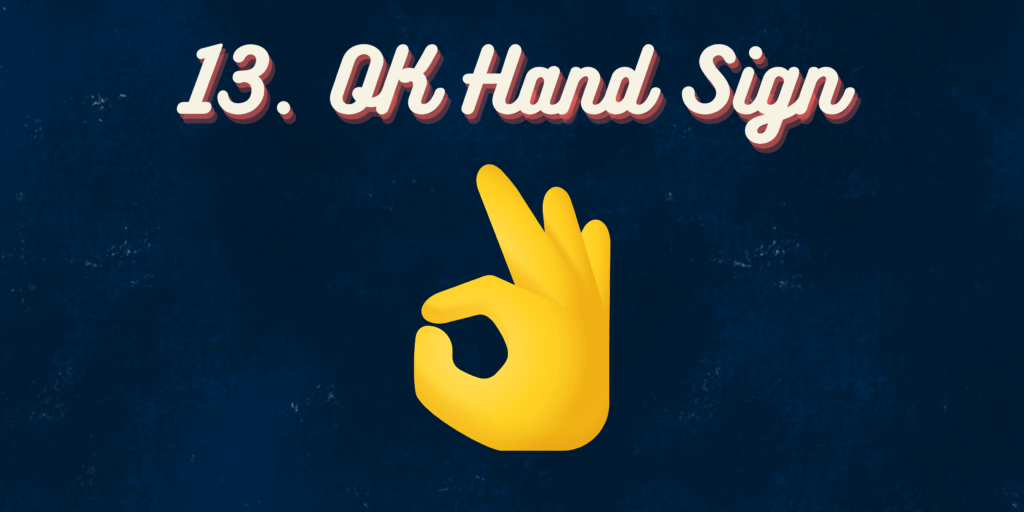
#14 Most Popular Emoji: Eye Roll
The eye-roll emoji has become widely popular due to its versatility in conveying various emotions and attitudes through digital communication. One of its primary uses is to express disapproval or skepticism. When someone encounters a statement or situation they find disagreeable or dubious, they might use the eye-roll emoji to subtly communicate their disdain or disbelief. Its eye-rolling gesture conveys a sense of annoyance or exasperation, making it an effective tool for expressing frustration in a lighthearted or playful manner.
Furthermore, the eye-roll emoji serves as a form of non-verbal communication in digital interactions. In face-to-face conversations, people often use facial expressions, including eye-rolling, to convey their feelings or opinions about a topic.
The emoji replicates this non-verbal cue in written communication, allowing individuals to express themselves more effectively in text-based conversations where tone and body language are absent. Whether it’s responding to a sarcastic remark, dismissing a ridiculous statement, or expressing mild irritation, the eye-roll emoji offers a quick and concise way to convey nuanced emotions without the need for lengthy explanations.
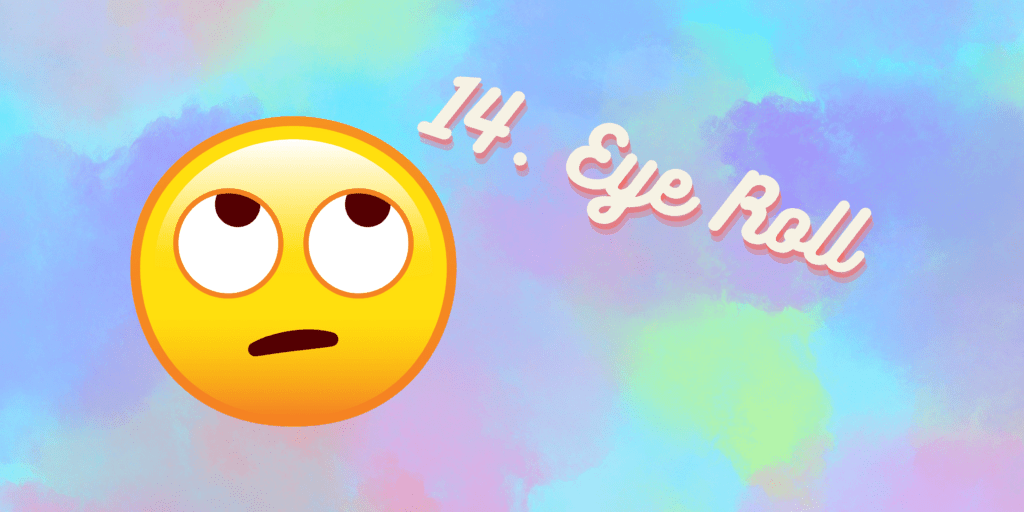
#15 Most Popular Emoji: Face with Pleading Eyes
The “Face with Pleading Eyes” emoji has garnered popularity for its effectiveness in conveying a range of emotions, primarily centered around vulnerability and earnestness. Its depiction of wide, pleading eyes and a slightly downturned mouth creates a visual representation of someone seeking compassion or understanding. This emotional appeal resonates with many users, making it a popular choice in digital communication.
One reason for its popularity is its ability to express emotion succinctly. In a single character, the “Face with Pleading Eyes” emoji encapsulates feelings of longing, supplication, or sincere request. It’s commonly used to convey a sense of pleading or imploring, whether it’s asking for a favor, seeking forgiveness, or expressing a desire for something.
Moreover, this emoji is effective in creating empathy. The depiction of vulnerability through the wide-eyed, pleading expression often prompts a compassionate response from the recipient. In text-based conversations where tone and body language are absent, emojis like this one serve as a means to convey emotions more vividly, fostering a deeper connection between individuals.
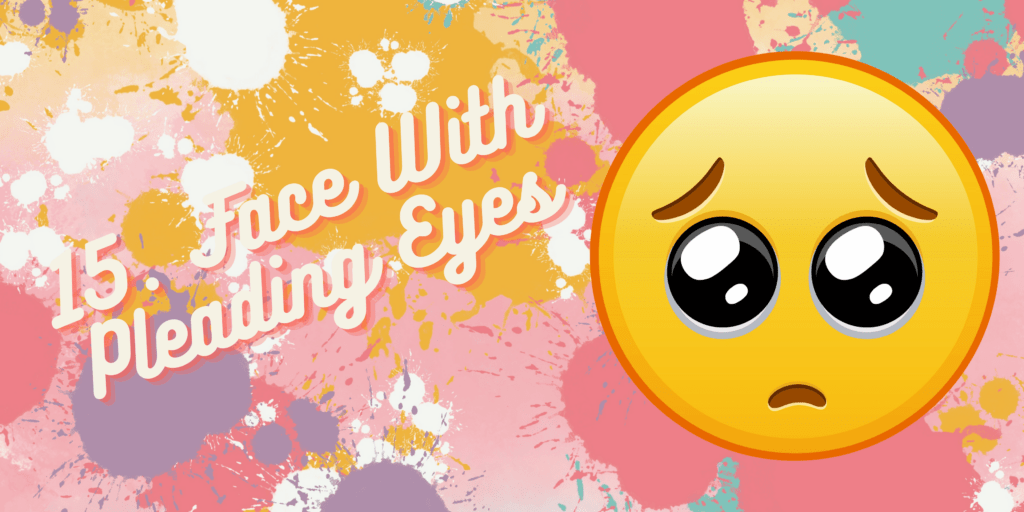
#16 Most Popular Emoji: Facepalm
The “Facepalm” emoji has become widely popular due to its ability to convey a sense of frustration, disbelief, or embarrassment in digital communication.
One of the primary reasons for its popularity is its universality in expressing exasperation or disappointment. The gesture of facepalming, where one brings their hand to their face in frustration or disbelief, is instantly recognizable across cultures. The emoji captures this gesture succinctly, making it a convenient way to convey similar emotions in written communication.
The “Facepalm” emoji serves as a form of non-verbal communication in digital interactions. In face-to-face conversations, people often use the facepalm gesture to express incredulity or dismay at someone’s actions or words. In the absence of physical cues in online communication, the emoji fills this gap by allowing users to convey their reactions visually, adding depth and nuance to text-based conversations.
Additionally, the emoji’s versatility contributes to its widespread usage. It can be employed in a variety of contexts, from responding to a friend’s silly mistake to expressing frustration at a systemic issue. Its flexibility allows users to convey a range of emotions, from mild annoyance to outright disbelief, making it suitable for a wide array of situations.
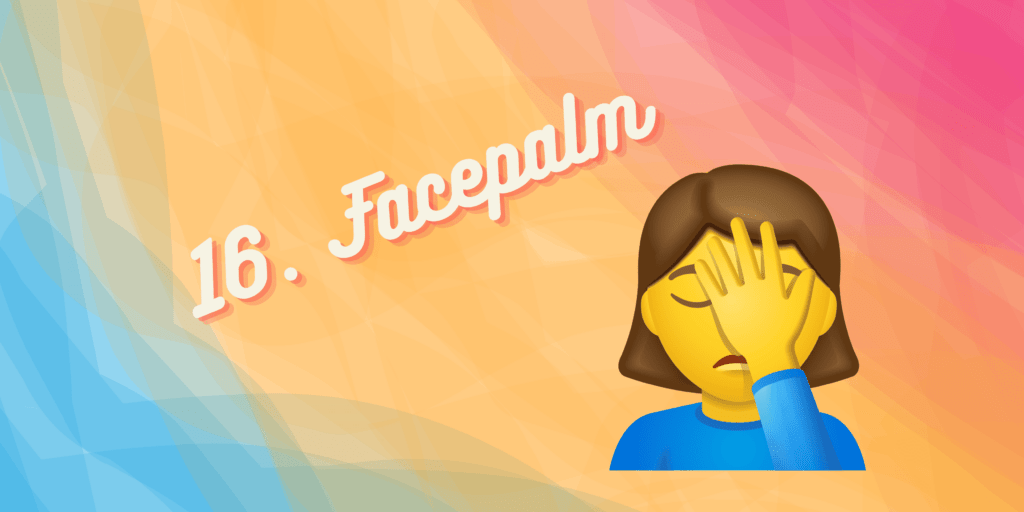
#17 Most Popular Emoji: Winking Face
The “Winking Face” emoji is one of the most popular emojis and is widely used in digital communication for various purposes. Firstly, the “Winking Face” emoji is versatile and can convey different meanings depending on the context. It’s often used to indicate humor, playfulness, or flirtation. When accompanied by a playful or teasing comment, the wink emoji can add a light-hearted tone to the conversation.
Moreover, the “Winking Face” emoji serves as a form of non-verbal communication in text-based conversations. It can help convey subtle nuances in tone that might otherwise be lost in written communication. For example, using the wink emoji at the end of a sarcastic remark can signal to the recipient that the comment is meant to be taken in jest.
Another reason for its popularity is its ability to create a sense of intimacy or camaraderie between the sender and recipient. A well-placed wink emoji can help establish a connection or inside joke between friends or acquaintances, adding a layer of familiarity to the conversation.
Additionally, the “Winking Face” emoji is visually appealing and easy to understand, making it accessible to a wide range of users. Its simple design—a smiling face with one eye closed—makes it instantly recognizable and suitable for a variety of digital platforms and devices.
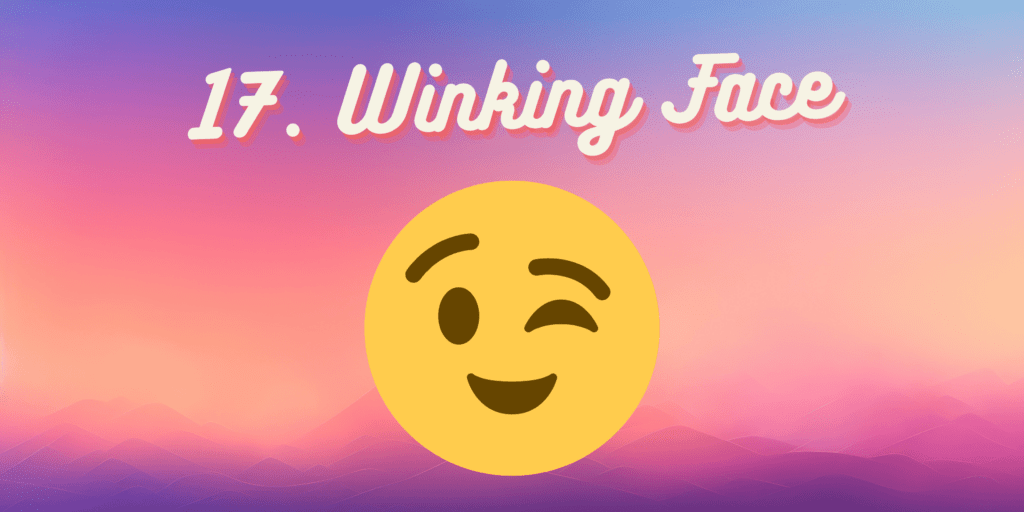
#18 Most Popular Emoji: Clapping Hands
The “Clapping Hands” emoji is a popular emoji widely used in digital communication to express appreciation, approval, or celebration.
Firstly, the “Clapping Hands” emoji is a visual representation of applause, a universal gesture of approval and acknowledgment. By using this emoji, people can show their support or admiration for something shared in a conversation, such as a job well done, an achievement, or an insightful comment.
Moreover, the emoji’s simplicity and immediacy make it a convenient tool for conveying positive feedback or encouragement in text-based conversations. Instead of typing out phrases like “well done” or “bravo,” users can simply insert the clapping hands emoji to express their appreciation succinctly.
Additionally, the “Clapping Hands” emoji can be used to create a sense of camaraderie and enthusiasm in group chats or social media posts. It’s often employed to celebrate milestones, accomplishments, or shared experiences, fostering a sense of community and support among participants.
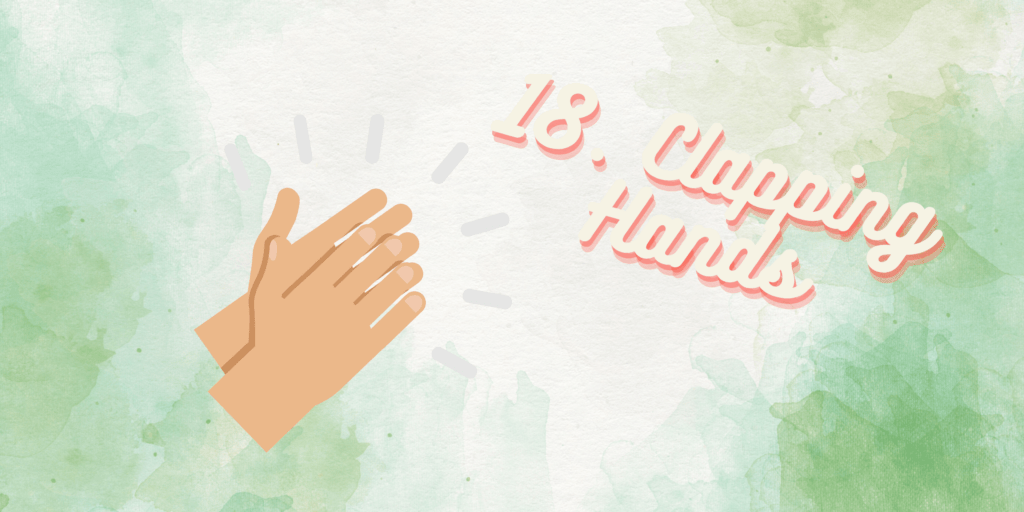
#19 Most Popular Emoji: Flexing Biceps
The “Flexed Biceps” emoji is immensely popular due to its representation of strength, power, determination, and resilience.
Primarily, this emoji visually communicates physical strength and fitness. It’s frequently employed in contexts associated with exercise, weightlifting, or athletic accomplishments. Users utilize it to celebrate personal fitness milestones, encourage others to engage in physical activity, or simply express admiration for someone’s physical abilities.
Furthermore, the “Flexed Biceps” emoji symbolizes resilience and unwavering determination. It serves as a visual cue for overcoming challenges, persevering through tough circumstances, or demonstrating commitment to achieving objectives. By incorporating this emoji, individuals can convey their resolve and fortitude in navigating obstacles.
Moreover, the emoji is often employed metaphorically to signify inner strength, determination, or resilience in facing life’s challenges. Its usage extends beyond physical prowess to encompass mental and emotional tenacity. This versatility allows users to express various forms of strength, whether it be physical, mental, or emotional, in diverse communication contexts.
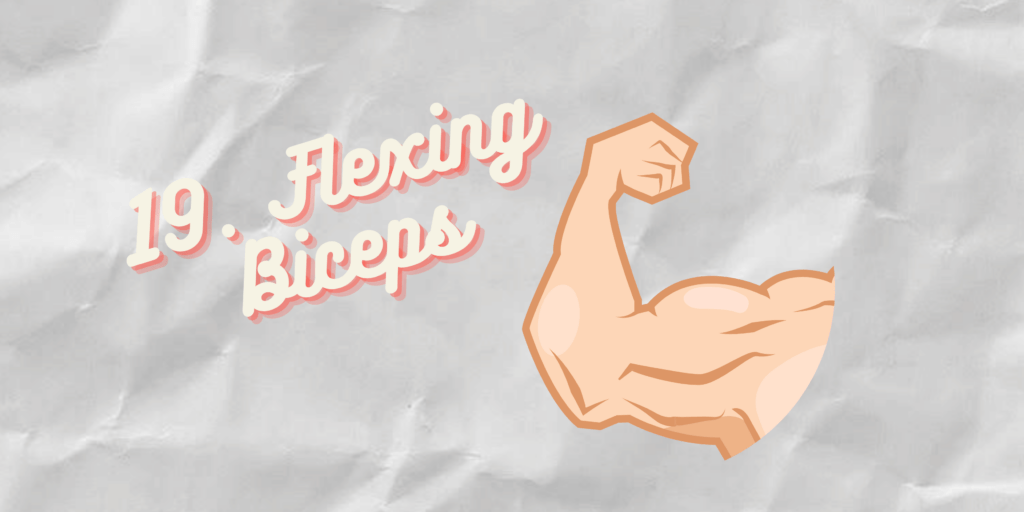
#20 Most Popular Emoji: Eyes
The “Eyes” emoji holds immense popularity due to its multifaceted interpretation in digital communication. Its usage is versatile and context-dependent. Often, it signifies vigilance or attention, with users employing it to call focus to a particular aspect of a conversation or to express their alertness. By using this emoji, individuals can convey that they are closely observing or paying attention to something being discussed.
Moreover, the “Eyes” emoji serves as a subtle means of indicating curiosity or interest. Its placement within a message can imply a desire for further information or clarification, prompting the recipient to elaborate on a topic. This emoji fosters engagement and encourages continued conversation by expressing a sense of intrigue or inquisitiveness.
Additionally, the emoji’s usage extends to conveying a range of emotions, depending on the context. It can represent astonishment, skepticism, or disbelief, particularly when paired with other emojis or text. For instance, using the “Eyes” emoji alongside a surprised expression can amplify the sense of wonder or incredulity being conveyed in the message.
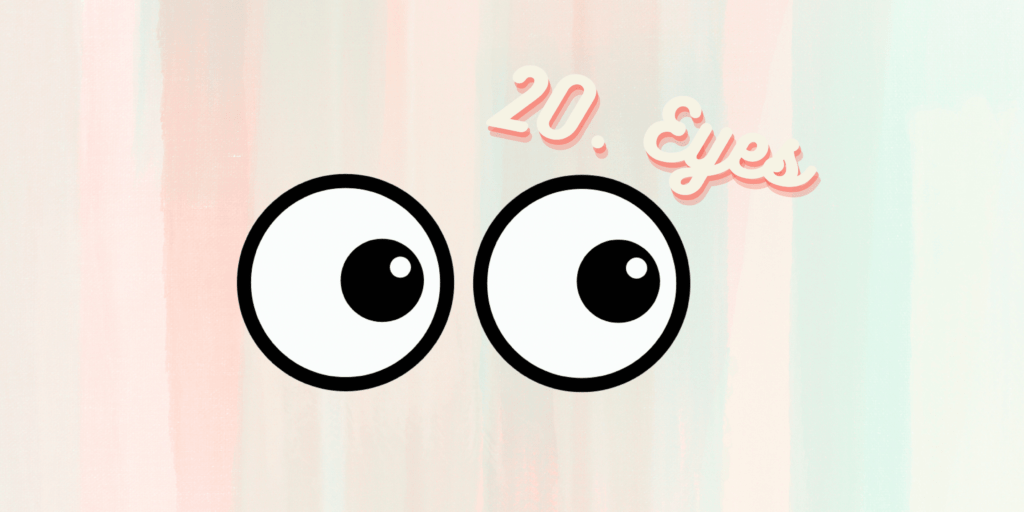
Emojis In Your Company’s Official Communications: What To Consider
- Brand image: Consider whether using emojis aligns with your company’s brand identity and image. For some brands, emojis may enhance a friendly and approachable tone, while for others, they may seem out of place or inconsistent with the brand’s professionalism.
- Target audience: Understand your target audience and their preferences. If your audience consists of younger demographics who are accustomed to using emojis in digital communication, incorporating them into your messages may resonate well. However, if your audience is more conservative or formal, emojis may be perceived as inappropriate.
- Industry norms: Evaluate industry norms and standards regarding communication style and professionalism. In some industries, such as technology or marketing, the use of emojis may be more common and accepted, while in others, such as finance or law, they may be less prevalent.
- Communication goals: Consider the purpose and tone of your communication. Emojis can add personality and convey emotions, but they may not always be suitable for conveying complex or sensitive information. Ensure that the use of emojis aligns with the intended message and communication goals.
- Consistency and moderation: If you decide to use emojis in official communications, maintain consistency in their usage and use them sparingly. Overuse of emojis can dilute their impact and detract from the professionalism of your messages.
- Test and evaluate: Before implementing emojis in official communications, consider testing them in a controlled environment or conducting surveys to gauge the reaction of your audience. Monitor feedback and performance metrics to evaluate the effectiveness of using emojis and make adjustments as needed.


